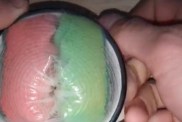Artwork: Francis Alÿs in collaboration with Julien Devaux, Rafael Ortega, Alejandro Morales, and Félix Blume. Paradox of Praxis 5: Sometimes we dream as we live & sometimes we live as we dream, Ciudad Juárez, México, 2013 (detail of video still). Video, 7:49 minutes, color, sound.
Ciudad Juárez. Population: 1.32 million in a city roughly 19 square miles along the border of the United States and Mexico. It’s a mythical city, one where the scale of violence and corruption is incomprehensible. It’s the site of a war that happens in broad daylight, only there’ are no good guys.
Also: Books | Eros Hoagland: Reckoning at the Frontier
For the past decade, the Juárez and Sinaloa cartels have been at war with themselves and the Mexican government to fill the void left by the demise of the Colombian Cali and Medellín cartels in the 1990s. It’s a tremendous empire driven by a relentless demand from United States citizens for narcotics of their choice—laws be damned. And just as it did in the past, drug money is valued over life, with deaths brutal and vicious, and the body counts entirely too high. In 2013, estimates set the death toll at 120,000, with an additional 27,000 missing.

Francis Alÿs, Linchados, 2010. Oil on canvas on wood, 7 1/8 x 5 3/8 inches (18 x 13.5 cm)
That same year, Belgian artist Francis Alÿs (b. 1959) made the major video installation Paradox of Praxis 5: Sometimes we dream as we live & sometimes we live as we dream, Ciudad Juárez, México. Produced in collaboration with Julien Devaux, Rafael Ortega, Alejandro Morales, and Félix Blume, Alÿs illustrates the challenge of creating beauty in a brutalized world. Here, Alÿs kicks a flaming soccer ball through Ciudad Juárez at night. It’s a shot in the dark, literally, and one that hides more than it reveals.
The film is now on view in Francis Alÿs: Ciudad Juárez projects at David Zwirner, London, now through August 5, 2016, along with other other works made between 2010–2015. Alÿs applies a poetic and imaginative sensibility towards anthropological and geopolitical concerns that he describes as “a sort of discursive argument composed of episodes, metaphors, or parables.”

Francis Alÿs, Untitled, 2013. Oil and pencil on canvas and wood, 8 1/4 x 6 inches (21 x 15.2 cm)
In Alÿs’s world, we see what remains during a period of war, one that operates under the cloak of darkness and on the black markets. The darkness of the night provides a cover for all that goes down, the sale of drugs, of women, of weapons, of whatever you want to buy. The cops don’t care unless they’re not getting their cut. Then there will be problems and there will be blood. But until that time comes it’s just another night in the hood.
The “Paradox of Praxis” is a question we must ask: what does it mean to create beauty in a land filled with death? What purpose does it serve? How does it help? With the ball as a guide, his path is illuminated only by the light from the fire, which he must strike with his foot in order to proceed. It is as Alÿs reveals, a shot in the dark—and an act of faith.

Francis Alÿs in collaboration with Julien Devaux, Rafael Ortega, Alejandro Morales, and Félix Blume. Paradox of Praxis 5: Sometimes we dream as we live & sometimes we live as we dream, Ciudad Juárez, México, 2013 (detail of video still). Video, 7:49 minutes, color, sound.
All artwork: Courtesy David Zwirner, New York/London.
Miss Rosen is a New York-based writer, curator, and brand strategist. There is nothing she adores so much as photography and books. A small part of her wishes she had a proper library, like in the game of Clue. Then she could blaze and write soliloquies to her in and out of print loves.




